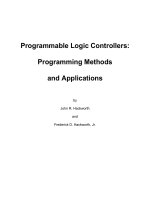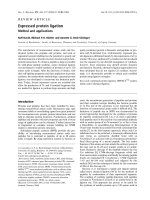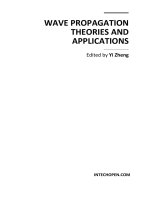WAVE PROPAGATION THEORIES AND APPLICATIONS docx
Bạn đang xem bản rút gọn của tài liệu. Xem và tải ngay bản đầy đủ của tài liệu tại đây (22.87 MB, 392 trang )
WAVE PROPAGATION
THEORIES AND
APPLICATIONS
Edited by Yi Zheng
Wave Propagation Theories and Applications
Edited by Yi Zheng
Contributors
Yi Zheng, Xin Chen, Aiping Yao, Haoming Lin, Yuanyuan Shen, Ying Zhu, Minhua Lu, Tianfu
Wang, Siping Chen, Mohamad Abed A. LRahman Arnaout, Alexey Androsov, Sven Harig,
Annika Fuchs, Antonia Immerz, Natalja Rakowsky, Wolfgang Hiller, Sergey Danilov, Hitendra K.
Malik, Alexey Pavelyev, Alexander Pavelyev, Stanislav Matyugov, Oleg Yakovlev, Yuei-An Liou,
Kefei Zhang, Jens Wickert, Mir Ghoraishi, Jun-ichi Takada, Tetsuro Imai, Michal Čada, Montasir
Qasymeh, Jaromír Pištora, Z. Menachem, S. Tapuchi, Kazuhito Murakami, Émilie Masson, Pierre
Combeau, Yann Cocheril, Lilian Aveneau, Marion Berbineau, Rodolphe Vauzelle, Jorge Avella
Castiblanco, Divitha Seetharamdoo, Marion Berbineau, Michel Ney, François Gallée, Shahrooz
Asadi, Paulo Roberto de Freitas Teixeira, Somsak Akatimagool, Saran Choocadee, Hassan
Yousefi, Asadollah Noorzad
Published by InTech
Janeza Trdine 9, 51000 Rijeka, Croatia
Copyright © 2013 InTech
All chapters are Open Access distributed under the Creative Commons Attribution 3.0 license,
which allows users to download, copy and build upon published articles even for commercial
purposes, as long as the author and publisher are properly credited, which ensures maximum
dissemination and a wider impact of our publications. After this work has been published by
InTech, authors have the right to republish it, in whole or part, in any publication of which they
are the author, and to make other personal use of the work. Any republication, referencing or
personal use of the work must explicitly identify the original source.
Notice
Statements and opinions expressed in the chapters are these of the individual contributors and
not necessarily those of the editors or publisher. No responsibility is accepted for the accuracy
of information contained in the published chapters. The publisher assumes no responsibility for
any damage or injury to persons or property arising out of the use of any materials,
instructions, methods or ideas contained in the book.
Publishing Process Manager Marina Jozipovic
Typesetting InTech Prepress, Novi Sad
Cover InTech Design Team
First published January, 2013
Printed in Croatia
A free online edition of this book is available at www.intechopen.com
Additional hard copies can be obtained from
Wave Propagation Theories and Applications, Edited by Yi Zheng
p. cm.
ISBN 978-953-51-0979-2
Contents
Preface IX
Chapter 1 Shear Wave Propagation in Soft Tissue
and Ultrasound Vibrometry 1
Yi Zheng, Xin Chen, Aiping Yao, Haoming Lin, Yuanyuan Shen,
Ying Zhu, Minhua Lu, Tianfu Wang and Siping Chen
Chapter 2 Acoustic Wave Propagation
in a Pulsed Electro Acoustic Cell 25
Mohamad Abed A. LRahman Arnaout
Chapter 3 Tsunami Wave Propagation 43
Alexey Androsov, Sven Harig, Annika Fuchs, Antonia Immerz,
Natalja Rakowsky, Wolfgang Hiller and Sergey Danilov
Chapter 4 Electromagnetic Waves and Their Application
to Charged Particle Acceleration 73
Hitendra K. Malik
Chapter 5 Radio Wave Propagation Phenomena
from GPS Occultation Data Analysis 113
Alexey Pavelyev, Alexander Pavelyev, Stanislav Matyugov,
Oleg Yakovlev, Yuei-An Liou, Kefei Zhang and Jens Wickert
Chapter 6 RadioWave Propagation Through Vegetation 155
Mir Ghoraishi, Jun-ichi Takada and Tetsuro Imai
Chapter 7 Optical Wave Propagation in Kerr Media 175
Michal Čada, Montasir Qasymeh and Jaromír Pištora
Chapter 8 Analyzing Wave Propagation in Helical Waveguides
Using Laplace, Fourier, and Their Inverse Transforms,
and Applications 193
Z. Menachem and S. Tapuchi
VI Contents
Chapter 9 Transient Responses on Traveling-Wave Loop
Directional Filters 221
Kazuhito Murakami
Chapter 10 Ray Launching Modeling in Curved Tunnels
with Rectangular or Non Rectangular Section 239
Émilie Masson, Pierre Combeau, Yann Cocheril, Lilian Aveneau,
Marion Berbineau and Rodolphe Vauzelle
Chapter 11 Electromagnetic Wave Propagation Modeling
for Finding Antenna Specifications and Positions
in Tunnels of Arbitrary Cross-Section 261
Jorge Avella Castiblanco, Divitha Seetharamdoo,
Marion Berbineau, Michel Ney and François Gallée
Chapter 12 Efficient CAD Tool for Noise Modeling
of RF/Microwave Field Effect Transistors 289
Shahrooz Asadi
Chapter 13 A Numerical Model Based on Navier-Stokes
Equations to Simulate Water Wave Propagation
with Wave-Structure Interaction 311
Paulo Roberto de Freitas Teixeira
Chapter 14 Wave Iterative Method for Electromagnetic Simulation 331
Somsak Akatimagool and Saran Choocadee
Chapter 15 Wavelet Based Simulation of Elastic Wave Propagation 17
Hassan Yousefi and Asadollah Noorzad
Preface
A wave is one of the basic physics phenomena observed by mankind since ancient
times: water waves in the forms of ocean tides or ripples in a bucket, transverse body
waves of a snake, longitudinal body waves of an earth worm, sound echoes in caves,
shock waves of earthquakes, vibrations of drums and strings, light from a rising sun
and a falling moon, reflections of light from shiny surfaces, and many other forms of
mechanical and electromagnetic waves. Perhaps the most commonly experienced
wave by us is the sound wave used for oral communications.
The wave is also one of the most-studied phenomena in physics that can be well
described by mathematics. In fact, the study of waves and wave propagation was a
driving force for advancing the differential equation and vector calculus. The study
may be the best illustration of what is “science”, which approximates the laws of
nature by using human defined symbols, operators, and languages. One of such
fascinating examples is the Maxwell’s equations for electromagnetic waves.
Having a good understanding of waves and wave propagation can help us to improve
the quality of life and provide a pathway for future explorations of nature and the
universe. In the past, this good understanding enabled the inventions of medical
ultrasound, CT, MRI, and communications technologies that shaped both societies and
the global economy. In the future, it will continue to have a profound impact on an
ever-changing world, as communication between people and countries is helping to
reduce cultural barriers and improve mutual understanding for global peace.
As waves exist everywhere in our daily life, its known forms can be primarily divided
into two types: mechanical waves and electromagnetic waves. Both types of waves are
described by the basic parameters of amplitudes, phase, frequency, wavelength, and
others. The propagation of both mechanical and electromagnetic waves in different
mediums is characterized by the propagation speed, transmission, radiation,
attenuation, reflection, scattering, diffraction, dispersion, etc. The understanding of the
commonality of those waves provides us opportunities to work in interdisciplinary
areas for new discoveries and inventions. Ultimately, this will continue to benefit the
developments of communication devices, musical instrument, medical devices,
imaging devices, numerous sensor devices, and many others.
X Preface
One of the objectives of this book is to introduce the recent studies and applications of
wave and wave propagation in various fields. Although the work presented in this
book represents only a very small percentage of samples of the studies in recent years,
it introduces some exciting applications and theories to those who have general
interests in waves and wave propagation, and provides some insights and references
to those who are specialized in the areas presented in the book.
Most of the chapters present the theories and applications of electromagnetic waves
ranged from radio frequencies to optics, while the first three chapters related to
mechanical waves from tsunami to ultrasound and the last several chapters discuss
numerical methods and modeling for wave simulations. Varieties of theories and
applications presented in the book include ultrasound vibrometry for measuring shear
wave propagation in tissue, wave propagation analysis for radio-occultation remote
sensing, acoustic wave propagation induced by the pulsed electro-acoustic technique,
THz rays and applications to charged particle acceleration, wave propagation in
helical waveguides, traveling-wave loop directional filters, electromagnetic wave
propagation and antenna considerations in tunnels, RF wave propagation through
vegetation, optical wave propagation in Kerr media, new CAD model for microwave
FET, and numerical methods and modeling for wave simulations, etc.
We sincerely thank all authors, from around the world, for their contributions to this
book. I also appreciate Ms. Marina Jozipovic and Ms. Romana Vukelic for their work
to make this publication possible.
Yi Zheng, 郑翊
Department of Electrical and Computer Engineering,
St. Cloud State University,
Minnesota, USA
Chapter 1
© 2013 Zheng, licensee InTech. This is an open access chapter distributed under the terms of the Creative
Commons Attribution License ( which permits unrestricted use,
distribution, and reproduction in any medium, provided the original work is properly cited.
Shear Wave Propagation in Soft
Tissue and Ultrasound Vibrometry
Yi Zheng, Xin Chen, Aiping Yao, Haoming Lin, Yuanyuan Shen,
Ying Zhu, Minhua Lu, Tianfu Wang and Siping Chen
Additional information is available at the end of the chapter
1. Introduction
Studies have found that shear moduli, having the dynamic range of several orders of
magnitude for various biological tissues [1], are highly correlated with the pathological
statues of human tissue such as livers [2, 3]. The shear moduli can be investigated by
measuring the attenuation and velocity of the shear wave propagation in a tissue region.
Many efforts have been made to measure shear wave propagations induced by different
types of force, which include the motion force of human organs, external applied force [4],
and ultrasound radiation force [5].
In past 15 years, ultrasound radiation force has been successfully used to induce tissue motion
for imaging tissue elasticity. Vibroacoustography (VA) uses bifocal beams to remotely induce
vibration in a tissue region and detect the vibration using a hydrophone [5]. The vibration
center is sequentially moved in the tissue region to form a two-dimensional image. Acoustic
Radiation Force Imaging (ARFI) uses focused ultrasound to apply localized radiation force to
small volumes of tissue for short durations and the resulting tissue displacements are mapped
using ultrasonic correlation based methods [6]. Supersonic shear image remotely vibrates
tissue and sequentially moves vibration center along the beam axis to create intense shear plan
wave that is imaged at a high frame rate (5000 frames per second) [7]. These image methods
provide measurements of tissue elasticity, but not the viscosity.
Because of the dispersive property of biological tissue, the induced tissue displacement and
the shear wave propagation are frequency dependent. Tissue shear property can be
modeled by several models including Kelvin-Voigt (Voigt) model, Maxwell model, and
Zener model [8]. Voigt model effectively describes the creep behavior of tissue, Maxwell
model effectively describes the relaxation process, and the Zener model effectively describes
both creep and relaxation but it requires one extra parameter. Voigt model is often used by
Wave Propagation Theories and Applications
2
many researchers because of its simplicity and the effectiveness of modeling soft tissue.
Voigt model consists of a purely viscous damper and a purely elastic spring connected in
parallel. For Voigt tissue, the tissue motion at a very low frequency largely depends on the
elasticity, while the motion at a very high frequency largely depends on the viscosity [8]. In
general, the tissue motion depends on both elasticity and viscosity, and estimates of
elasticity by ignoring viscosity are biased or erroneous.
Back to the year of 1951, Dr. Oestreicher published his work to solve the wave equation for
the Voigt soft tissue with harmonic motions [9]. With assumptions of isotropic tissue and
plane wave, he derived equations that relate the shear wave attenuation and speed to the
elasticity and viscosity of soft tissue. However, Oestreicher’s method was not realized for
applications until the half century later.
In the past ten years, Oestreicher’s method was utilized to quantitatively measure both
tissue elasticity and viscosity. Ultrasound vibrometry has been developed to noninvasively
and quantitatively measure tissue shear moduli [10-16]. It induces shear waves using
ultrasound radiation force [5, 6] and estimates the shear moduli using shear wave phase
velocities at several frequencies by measuring the phase shifts of the propagating shear
wave over a short distance using pulse echo ultrasound [10-16]. Applications of the
ultrasound vibrometry were conducted for viscoelasticities of liver [16], bovine and porcine
striated muscles [17, 18], blood vessels [12, 19-21], and hearts [22]. A recent in vivo liver
study shows that the ultrasound vibrometry can be implemented on a clinical ultrasound
scanner of using an array transducer [23].
One of potential applications of the ultrasound vibrometry is to characterize shear moduli of
livers. The shear moduli of liver are highly correlated with liver pathology status [24, 25].
Recently, the shear viscoelasticity of liver tissue has been investigated by several research
groups [23, 26-28]. The most of these studies applied ultrasound radiation force in liver
tissue regions, measured the phase velocities of shear wave in a limited frequency range,
and inversely solved the Voigt model with an assumption that liver local tissue is isotropic
without considering boundary conditions. Because of the boundary conditions, shear wave
propagations are impacted by the limited physical dimensions of tissue. Studies shows that
considerations of boundary conditions should be taken for characterizing tissue that have
limited physical dimensions such as heart [22], blood vessels [19-21], and liver [8], when
ultrasound vibrometry is used.
2. Shear wave propagation in soft tissue and shear viscoelasticity
The shear wave propagation in soft tissue is a complicated process. When the tissue is
isotropic and modeled by the Voigt model, the phase velocity and attenuation of the shear
wave propagation in the tissue are associated with tissue viscoelasticity. Oesteicher
documented the detailed derivations of the solution of the sound wave equation for Voigt
tissue [9]. We extended the solution to other models [8] for the applications of ultrasound
vibrometry [8]. In this section, we provide the simplified descriptions of the shear wave
propagation in tissue modeled by Voigt model, Maxwell model, and Zener model.
Shear Wave Propagation in Soft Tissue and Ultrasound Vibrometry
3
Assuming that a harmonic motion produces the shear wave that propagates in a tissue
region, the phase velocity c
s(ω) of the wave can be estimated by measuring the phase shift
Δ
ϕ
over a distance Δz:
() /
s
cz
(1)
The phase velocity is associated with the tissue property, which can be found by solving the
wave equation with a tissue viscoelasticity model. For a small local region, the wave is
approximated as a uniform plane wave, which has a simple form in isotropic medium:
2
2
2
0
d
k
dz
S
S
(2)
where S is the phasor notation of the displacement of the time-harmonic field of the shear
wave, z is the wave propagation distance which is perpendicular to the direction of the
displacement of the shear wave, and the complex wave number is
ri
kk ik
(3)
The solution of (2) is a standard solution of a homogeneous wave equation:
0
ˆ
ikz
xS e
S
(4)
where S
0 is the displacement at z = 0, is an unit vector in x direction. The plane wave is
independent in y direction. The real time time-harmonic shear wave is:
0
ˆˆ
(,,) Re cos( )
i
kz
it
r
Sztx e xSe tkz
S (5)
Although attenuation coefficient α = –k
i carries information of the complex modulus of
tissue, the phase measurement is often more reliable because it is relatively independent to
transducers and measurement systems. The phase velocity is the speed of the wave
propagating at a constant phase, which is a solution of ( ) / 0
r
dtkzdt
:
() /
sr
dz
ck
dt
(6)
The complex wave number k of the plane shear wave is a function of the frequency and the
complex modulus of the medium [9]:
2
/
k
(7)
where ρ is the density of the tissue and the complex modulus that connects stress σ and
strain ε:
12
/ i
(8)
Wave Propagation Theories and Applications
4
which describes the relationship between stress and strain in the Voigt tissue. The Voigt
model consists of an elastic spring μ
1 and a viscous damper μ2 connected in parallel, which
represents the same strain in each component as shown in Figure 1.
Figure 1. Voigt model consists of an elastic spring μ1 and a viscous damper μ2 connected in parallel.
The relation between stress σ and strain ε of the Maxwell tissue is:
12
d
dt
(9)
For a harmonic motion, (9) becomes:
12
()i
(10)
which is the same as (8). Substituting (8) into (7) and finding the real part of the wave
number, the phase velocity of the shear wave in Voigt tissue can be obtained from (6):
222
12
222
11 2
2( )
()
(
s
c
(11)
The elasticity μ
1 and viscosity μ2 are two constants and independent to the frequency.
A numerical example of phase velocity of Voigt tissue is shown in Figure 2. Equation (11)
shows that c
s(ω) increases at the rate of square root of the frequency and there is no the
upper limit for c
s(ω). As shown in the Figure 2, the phase velocity is determined by both
elasticity and viscosity. Ignoring the viscosity introduces errors and biases for elasticity
estimates. However, examining the velocities at the extreme frequencies is useful for
understanding the model and obtaining initial values for numerical solutions of μ
1 and μ2.
In tissue characterization applications, μ
1 is often in the order of a few thousands and μ2 is
often less than 10. Thus, when the wave frequency is very low (less than a few Hz),
2
1
( ) very low .
s
c
(12)
When the frequency is very high (higher than a few tens of kHz),
2
2
( ) / 2 very high .
s
c
(13)
Shear Wave Propagation in Soft Tissue and Ultrasound Vibrometry
5
Figure 2. Plot of phase velocity of shear wave having μ1=3 kpa and μ2=1 pa.s in Voigt tissue
A broad frequency range is needed to accurately estimate both μ1 and μ2. (12) and (13) are
only useful for estimating initial values for the numerical solutions of (11) with measured
velocities, and they should not be used for final estimates.
Equation (7) can be used for other models for the plane shear wave having a single frequency.
The Maxwell model consists of a viscous damper η
and an elastic spring E connected in series,
which represents the same stress in each component, as shown in Figure 3.
Figure 3. Maxwell model consists of a viscous damper η and an elastic spring E connected in series.
The relation between stress σ and strain ε of the Maxwell tissue is:
1 dd
Edt dt
(14)
For a harmonic motion, (14) becomes:
22 2
222 222
iE E E
i
Ei
EE
(15)
which is the complex shear modulus of the Maxwell model. Unlike the Voigt model, real
and imaginary components of (15) are functions of the frequency. When the frequency is
Wave Propagation Theories and Applications
6
fixed, the complex modulus is a function of and E. Substituting (15) into (7), the shear
wave speed in Maxwell medium can be found from (6):
222
2
()
(1 1
s
E
c
E
(16)
Equation (16) can be also obtained by replacing μ
1 and μ2 of (8) with the real and imaginary
terms of (15).
A numerical example of phase velocity of Maxwell tissue is shown in Figure 4. Note that
c
s(ω) gradually increases to a limit that is proportional to the square root of the elasticity. As
shown in the Figure 4, the phase velocity is determined by both elasticity and viscosity.
However, examining the velocities at the extreme frequencies is useful for understanding
the model and obtaining initial values for numerical solutions of E and η.
2
()
s
EC
for a
very large ω,
2
()/2
s
C
for a very small ω, cs(ω) is zero for ω=0, and cs(ω) approaches
/E
when ω is very high.
Figure 4. Plot of phase velocity of shear wave having E = 7.5 kpa and η = 6 pa.s in Voigt tissue
Figure 5. Zener model adds an elastic spring E1 to the Maxwell model (η, E2) in parallel.
Shear Wave Propagation in Soft Tissue and Ultrasound Vibrometry
7
The Zener model adds an additional elastic spring, having the elasticity of E1, to the Maxwell
model (η, E
2) in parallel. The Zener model combines the features of the Voigt model and the
Maxwell models and describes both creep and relaxation. Based on the Maxwell model, the
complex shear modulus of the Zener model can be readily obtained:
22 2
222
11
222 222
2
22
iE E E
EE i
Ei
EE
(17)
Substituting (17) into (7), the shear wave speed in Zener medium can be found from (6):
22 2 22
12 12
22 2 22 2 22 22 2
12 12 12 12 2
2( ( ) )
()
(( ) (( ) )( )
s
EE EE
c
EE EE EE EE E
(18)
Equation (18) shows that
2
12
()
s
EE C
for a very large ω,
2
1
()
s
EC
for a very small
ω,
η is proportional to the slop of the speed curve, and cs(ω) approaches
12
/EE
when
ω is very high. A numerical example of phase velocity of Zener tissue is shown in Figure 6.
Figure 6. Plot of phase velocity of shear wave having E1 = 4.5 kpa, η = 1.5 pa.s, and E2 =7.5 ka in Zener
tissue
3. Ultrasound vibrometry
Ultrasound vibrometry has been developed to induce shear wave in a tissue region,
measure phase velocity of the shear wave, and calculate the tissue viscoelasticity based on
(11), or (16), or (18). The basics of the ultrasound vibrometry are described in details in
references [11-17, 32]. Ultrasound vibrometry induces tissue vibrations and shear waves
Wave Propagation Theories and Applications
8
using ultrasound radiation force and detects the phase velocity of the shear wave
propagation using pulse-echo ultrasound.
From the solution of the wave equation, equation (5) can be represented by a harmonic
motion at a location,
() sin( )
ss
dt D t
(19)
where
s=2
fs is the vibration angular frequency, the vibration displacement amplitude D and
phase
s depend on the radiation force and tissue property. (19) is another representation of
(5). Applying detection pulses to the motion that causes the travel time changes of detection
pulses and phase shift changes of the return echoes, the received echo becomes [11]:
00
(, ) (, )cos sin( ( ) )
ss
rtk gtk t t kT
(20)
where T is the period of the push pulses shown in Figure 9 and the modulation index is:
0
2cos()/Dc
(21)
where
c is the sound propagation speed in the tissue,
0 is the angular modulation frequency
of detection tone bursts,
g(t,k) is the complex envelope of r(t,k),
0 is a transmitting phase
constant and
is an angle between the ultrasound beam and the tissue vibration direction.
Received echo
r(t,k) is a two-dimensional signal. When one detection pulse is transmitted, its
echo from the different depth of tissue is received as
t changes. In medical ultrasound field,
variable
t is called fast time. When multiple detection pulses are transmitted, the multiple
echo sequences are received as k changes. Variable k is called as slow time.
r(t,k) in fast-time
t is called as fast-time signal to represent the echo signal in beam axial direction or the depth
location in the tissue. Its variation in slow-time
k is called slow-time signal to represent the
signals from one echo to another echo. If there is no tissue motion,
r(t,k) will be the same for
different k values. The tissue motion information is carried by modulation index β and
phase
s. A quadrature demodulator is used to obtain β and phase
s.
As shown in Figure 7, a quadrature demodulator is applied to extract the motion information
from
r(t,k). The complex envelop consists of the in-phase and quadrature term [29]:
(
,
)
=
(
,
)
+(,) (22)
Operating on the in-phase and quadrature components
I and Q with input r(t,k), we obtain
the tissue motion in slow time [11]:
11
( , ) tan ( / ) mean of tan ( / ) sin ( )
A
ss
stk QI QI tkT
(23)
A phase constant can be added to the local oscillator of the demodulator [11] to avoid zeros
in I. The signal extracted by (23) is proportional to the displacement of a harmonic motion
induced by the push pulses.
Shear Wave Propagation in Soft Tissue and Ultrasound Vibrometry
9
Figure 7. Block diagram of quadrature demodulator
Another motion detection method [14] uses a complex vector that is a multiplication
between two successive complex envelops [29]
*
,
i, ,1 ,Xtk Ytk gtk g tk
(24)
Thus, the motion velocity in slow time can be obtained,
1
(, )
(, ) tan 2 sin( /2)cos ( ) /2
(, )
Bssss
Ytk
stk T t kT T
Xtk
(25)
which is proportional to the velocity of the tissue harmonic motion for
ωsT/2 << 1. Thus,
sin
(ωsT/2) ≈ ωsT/2 and the velocity amplitude is
s
T
, which is also
0
/2 cos( )
ss
Dc
because of the derivative relation between (19) and (25)
The slow-time signal s(t,k) represents the tissue motion at a particular location, its
amplitudes and phases change over distances are described by (5). The measurements of
amplitudes and phases at two locations are used to calculate attenuation and phase velocity.
As shown in (1), the phase velocity is related to the frequency and inversely related to the
phase difference Δ
ϕ
over a short distance Δd. Thus, estimating the phase differences is the
key step of the ultrasound vibrometry. The phase difference can be obtained by comparing
phases
ϕ
s of the slow-time signals s(t,k) at two locations z and z+Δz:
ϕ=ϕ
(z)−ϕ
(z+Δz) (26)
There are several methods to estimate the phases of slow-time signals: Fourier transform,
correlation method, and Kalman filter [14]. The estimated phase of the slow-time signal at a
location include some phase constants due to the tissue location t and different pulse k, and
phase
ϕ
s = -krz. Given a tissue location (axial location) in fast time, all constant phases are
removed by (26) except the phase shift
ϕ in the lateral location.
Ultrasound vibrometry is developed to induce the shear wave described by (19) and detect
the phase shift
ϕ described by (26) for characterizing the tissue shear property using (1)
Wave Propagation Theories and Applications
10
and (11), (14), and (16). Ultrasound virbometry uses interleaved periodic pulses to induce
shear wave and detects the phase velocity of shear wave propagation using pulse-echo
ultrasound. Figure 8 shows an application setup of the ultrasound vibrometry. An
ultrasound transducer transmits push beams to a tissue region to induce vibrations and
shear waves. The push beams are periodic pulses that have a fundamental frequency
fv and
harmonics
nfv. During the off period of the push pulses, the detection pulses are transmitted
and echoes are received by the transducer at lateral locations that are away from the center
of the radiation force applied, as shown in Figure 9. In some of our applications,
fundamental frequency f
v of the push pulses is in the order of 100 Hz, and pulse repetition
frequency f
PRF of the detection pulses is in the order of 2 kHz.
Figure 8. Array transducer for transmitting ultrasound radiation force and detecting shear wave
propagation
Figure 9. Interleaved push pulses for ultrasound radiation force and detection pulses
There are different variations of the excitation pulses beside the on-off binary pulses:
continuous waves [11], non-uniform binary pulses [15], and composed pulses or Orthogonal
Frequency Ultrasound Vibrometry (OFUV) pulses [30, 31]. The OFUV pulses can be
designed to enhance higher harmonics to compensate the high attenuations of high
harmonics. The OFUV pulses have multiple binary pulses in one period of the fundamental
Shear Wave Propagation in Soft Tissue and Ultrasound Vibrometry
11
period [30, 31]. Other variations of the ultrasound vibrometry include consideration of
background motion and boundary conditions that require more complicated models of
tissue motions [13] and wave propagations [22].
4. Finite element simulation of shear wave propagation
Simulations using Finite Element Method (FEM) were conducted to understand the shear
wave propagation in tissue. The simulation tool is COMSOL 4.2. The simulated tissue region
is a two-dimensional axisymmetric finite element model of a viscoelastic solid with a
dimension of 100 mm × 100 mm, as shown in Figure 10. The size of domain Ω1 is 100 mm ×
80 mm. The domain is divided to 25,371 mesh elements and the average distance between
adjacent nodes is 0.95 mm. The schematic diagram shown in Figure 10 includes simulation
domains (Ω1, Ω2, Ω3) and boundaries (B1,B2). A line source (with a length of 60 mm) in the
left of the solid represents as an excitation source of the shear wave.
Figure 10. Schematic diagram of simulated tissue region (domain) and
All domains had the same material property of the Voigt tissue and all boundaries were set
free to avoid reflections. The material parameters were: density of 1055 kg/m
3
, Poisson’s ratio
of 0.499, and Voigt rheological model of the viscoelasticity model. The Voigt model was
converted and represented in the form of Prony series. The store modulus and loss modulus
were calculated using frequency response analysis for demonstrating the conversion of the
Prony series. The complex shear modulus of the Voigt model is the same as (8):
μ
(
)
=
+μ
where elasticity modulus
µ1 and viscosity modulus µ2 were set to be 2 kPa and 2 Pa*s,
respectively, in this simulation.
Transient analysis was used and the time step for solver was one eightieth of the time period
of the shear wave. Uniform plane shear wave was produced by oscillating the line source
with ten cycles of harmonic vibrations in the frequency range from 100 Hz to 400 Hz with a
Wave Propagation Theories and Applications
12
maximal displacement in the order of tens of micrometers. The displacements of the shear
wave were recorded for post-processing at 8 locations, 1 mm apart, along a straight line that
is normal to the line source. The phases of the wave were estimated by the Kalman filter and
the average phase shifts were estimated using a linear fitting method [14]. The estimates of
shear wave velocity and viscoelasticity are shown in Table 1.
Shear Wave Velocity (m/s) Viscoelasitcity Estimation
100Hz 200Hz 300Hz 400Hz µ1(kPa) µ2(Pa*s)
Reference value 1.5574 1.9372 2.3470 2.7362 2 2
Measurement 1 1.46238 1.91972 2.37439 2.66872 1.69 1.90
Measurement 2 1.50648 1.94791 2.42833 2.8663
7
1.63 2.10
Measurement 3 1.52748 1.92955 2.46275 2.81089 1.74 2.10
Average 1.49479 1.9216 2.44359 2.77296
1.69±0.056 2.03±0.11
Std 0.02828 0.02455 0.05672 0.0851
7
Table 1. Estimated Viscoelasticity of Voigt tissue having µ1 = 2 kPa and µ2 = 2 Pa*s
The shear wave velocities in red represent the theoretical values of wave speeds in Voigt
tissue. The estimates of the speeds and viscoelasticity moduli of three simulations are shown
by three sets of the measurement. Their average values are close to the theoretical values
as shown in Figure 11, except the elasticity
µ1. Note that the differences between the average
velocities and the reference velocities are less than 9% but the estimate error of
µ1 is 15.5%. It
is due to the fact that viscoelasticity moduli are proportional to the square of the phase
velocity. Any small estimation errors of phase introduce large biases in the estimates of
viscoelasticity, which is an intrinsic weakness of the ultrasound vibrometry, demonstrated by
this example.
100 150 200 250 300 350 400
1.2
1.5
1.8
2.1
2.4
2.7
3.0
3.3
Shear Wave Velocity (m/s)
Frequency (Hz)
Reference Values
Estimation Values
Figure 11. Estimated shear phase velocities and set reference values
Shear Wave Propagation in Soft Tissue and Ultrasound Vibrometry
13
5. Experiment system and results
Experiments were conducted for evaluating ultrasound vibrometry. The diagram of an
experiment system is shown in Figure 12. This system mainly consists of a transmitter to
produce the ultrasound radiation force and a receiver unit using a SonixRP system. Two
arbitrary signal generators were utilized to generate the system timing and excitation
waveform. The waveform was amplified by a power amplifier having a gain of 50 dB to drive
an excitation transducer for inducing vibrations in a tissue region. The SonixRP system was
applied to detect the vibration using pulse-echo mode with a linear array probe. The SonixRP
is a diagnostic ultrasound system packaged with an Ultrasound Research Interface (URI). It
has some special research tools which allow users to perform flexible tasks such as low-level
ultrasound beam sequencing and control. The center frequency of the excitation transducer
was 1 MHz. The center frequency of the linear array probe was 5 MHz and the sampling
frequency of SonixRP was 40 MHz. The excitation transducer and detection transducer were
fixed on multi-degree adjustable brackets and were controlled by three-axis motion stages.
Figure 12. Block diagram of the experiment system
The picture of experiment system setup is shown in Figure 13. The left lobe of a SD rat liver
was embedded in gel phantom and placed in water tank. Before experiment, the SonixRP
URI was run first to preview the internal structure of the liver. In the interface shown in
Figure 14, the B-mode image and RF signal of a selected scan line were displayed together to
help users selecting test points inside the liver tissue. The positions of the excitation
transducer and the detection probe were adjusted to focus on two locations in the liver at
the same vertical depth.









